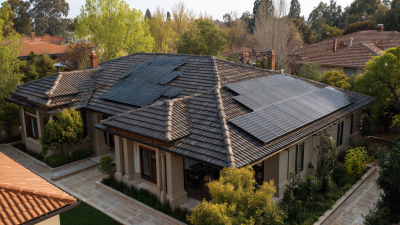Ultimate Guide to Harnessing Solar Power Tiles for Sustainable Energy Solutions
In the quest for sustainable energy solutions, solar power tiles have emerged as a revolutionary technology that not only enhances energy efficiency but also integrates seamlessly into our living spaces. These innovative tiles transform rooftops into energy-generating surfaces, harnessing the sun's abundant energy while maintaining aesthetic appeal. As more homeowners and businesses recognize the potential of solar power tiles, understanding their installation, maintenance, and benefits becomes essential. This ultimate guide will delve into the various aspects of solar power tiles, offering step-by-step insights on how to effectively incorporate them into your energy strategy. Whether you are considering a complete solar overhaul or simply curious about how these tiles can contribute to your sustainability goals, this guide will provide you with the knowledge needed to embrace this eco-friendly technology and help you make informed decisions for a greener future.

Understanding Solar Power Tiles: What They Are and How They Work
Solar power tiles represent an innovative solution in the quest for sustainable energy. Unlike traditional solar panels, these tiles are designed to seamlessly integrate into a building's architecture. Made from photovoltaic materials, they capture sunlight and convert it into electricity, allowing homeowners to generate their own power while maintaining the aesthetic appeal of their rooftops. Each tile functions independently, ensuring that even if some tiles are shaded, others can continue to produce energy efficiently.
The technology behind solar power tiles involves intricate layering of materials that maximize sunlight absorption and energy conversion. Typically, these tiles are durable and can withstand varying weather conditions, making them a practical choice for residential and commercial buildings alike. As they become more widely adopted, solar tiles not only contribute to energy savings but also promote a reduction in carbon emissions, positioning them as a key player in the transition to renewable energy sources. With advancements in technology and decreasing costs, solar power tiles are an exciting development for anyone looking to embrace eco-friendly energy solutions.
Ultimate Guide to Harnessing Solar Power Tiles for Sustainable Energy Solutions
| Feature | Description | Benefits | Considerations |
|---|---|---|---|
| Material | Solar power tiles are typically made from high-efficiency photovoltaic materials. | Durable and efficient energy conversion. | Initial cost may be higher than traditional solar panels. |
| Installation | Tiles can be integrated into roofing materials for seamless installation. | Enhances aesthetic appeal while providing energy. | May require professional installation. |
| Efficiency | Average efficiency rates of solar tiles range from 15% to 20%. | Can significantly lower electricity bills. | Efficiency may vary based on tile type and installation. |
| Lifespan | Solar tiles typically last 25 years or more with proper maintenance. | Long-term investment with continuous energy savings. | Regular inspections are necessary to ensure optimal performance. |
| Environmental Impact | Solar tiles significantly reduce carbon footprint by generating clean energy. | Contributes to a sustainable energy future. | Production may involve environmental considerations. |
Key Benefits of Integrating Solar Power Tiles into Your Energy System
Integrating solar power tiles into your energy system offers a multitude of benefits that can significantly enhance sustainability efforts. According to the International Energy Agency (IEA), solar energy could contribute over 30% of global electricity generation by 2030. By utilizing solar power tiles—innovative materials that blend seamlessly with roofing systems—homeowners can harness the sun's energy while maintaining aesthetic appeal. These tiles not only provide a renewable energy source but also reduce reliance on fossil fuels, aligning with global climate goals.

A significant advantage of solar power tiles is their durability and efficiency. Recent studies, including one from the National Renewable Energy Laboratory (NREL), report that modern solar tiles can achieve efficiencies of up to 22%, comparable to traditional solar panels. Additionally, with advancements in technology, the longevity of solar tiles has improved, often exceeding 25 years, which offers a long-term return on investment. Furthermore, installing solar tiles can contribute to energy independence, as households can generate their own power, potentially leading to up to 90% reduction in electricity costs, as suggested by the Solar Energy Industries Association (SEIA). Integrating solar power tiles promises to be a game-changer in the transition to sustainable energy systems.
Step-by-Step Guide to Installing Solar Power Tiles on Your Roof
Installing solar power tiles on your roof is an increasingly popular choice for homeowners looking to harness renewable energy. According to the Solar Energy Industries Association (SEIA), solar installations in the U.S. grew by over 20% in 2022 alone, demonstrating a strong trend towards sustainable energy solutions. Solar tiles, in particular, offer an attractive alternative to traditional solar panels, seamlessly blending with the roof’s aesthetic while generating clean energy.
The installation process for solar power tiles begins with a comprehensive assessment of your roof’s condition and orientation. A study by the National Renewable Energy Laboratory (NREL) indicates that south-facing roofs receive the most sunlight, making them ideal for solar tile installations. Once the assessment is complete, ensure that you choose high-efficiency tiles, as they can convert up to 20% of sunlight into energy. Professional installation is crucial; studies have shown that improperly installed systems can reduce energy output by as much as 30%. By following a step-by-step guide and investing in quality materials, homeowners can effectively transition to solar energy and contribute to a more sustainable future.
Tips for Maintenance and Optimizing Performance of Solar Power Tiles
When integrating solar power tiles into your energy system, maintenance and performance optimization are critical for maximizing their efficiency and longevity. According to a report by the National Renewable Energy Laboratory (NREL), effective maintenance can enhance solar panel efficiency by up to 25%. Regular cleaning and inspection are essential; keeping solar tiles free of debris, dirt, and snow will ensure optimal sunlight absorption, especially in regions prone to heavy rainfall or snow.
To maintain your solar tiles, consider implementing these tips: First, schedule annual professional inspections to identify potential issues early, such as cracks or loose connections. Second, utilize monitoring tools that can provide real-time data on your system's performance, allowing you to detect decreases in efficiency promptly. Lastly, ensure that your mounting structures are secure and well-maintained, as instability can lead to misalignment and reduced energy output.
Furthermore, optimizing the angle and orientation of your solar tiles can significantly impact performance. Research shows that a 15-degree tilt can enhance solar collection by approximately 20% during winter months. Continuous assessment of environmental factors such as shading from nearby trees or buildings can help in determining the best position for solar tiles, ensuring that your sustainable energy solution remains effective year-round.

Exploring Financial Incentives and Rebates for Solar Power Tile Installation
Installing solar power tiles is not only an eco-friendly choice but also an economically sound investment, thanks to various financial incentives and rebates available. Many governments and organizations offer tax credits that significantly reduce the upfront costs of installation. For instance, the federal solar tax credit allows homeowners to deduct a substantial percentage of their installation costs from their federal taxes, paving the way for quicker returns on investment.
Tip: Before moving forward, research local and state incentives, as they can vary widely. Some states provide additional rebates, grants, or low-interest loans for solar tile installations, which can further enhance your savings. Additionally, reaching out to local utility companies can uncover programs they may offer that encourage solar energy adoption.
Moreover, financing options like solar loans or leases can make the transition more manageable. With these programs, homeowners can install solar tiles with little to no upfront payment, paying off their investment through their energy savings over time.
Tip: Always compare different financing options to find the one that best fits your budget and financial goals. This will help you unlock the full potential of solar power tiles while ensuring you take advantage of every financial benefit available.
Related Posts
-

Navigating Import and Export Certifications for the Best PV Tiles in the Global Market
-

The Future of Sustainable Living with Solar Roof Tiles
-

Exploring the Revolution: What are Solar Cell Roof Tiles and Their Benefits?
-

What Makes Solar Panel Tiles a Smart Choice for Sustainable Energy Solutions
-

How to Maximize Energy Efficiency with PV Tiles: Insights and Innovations in Solar Technology
-

Understanding Issues with pv tiles in Modern Construction